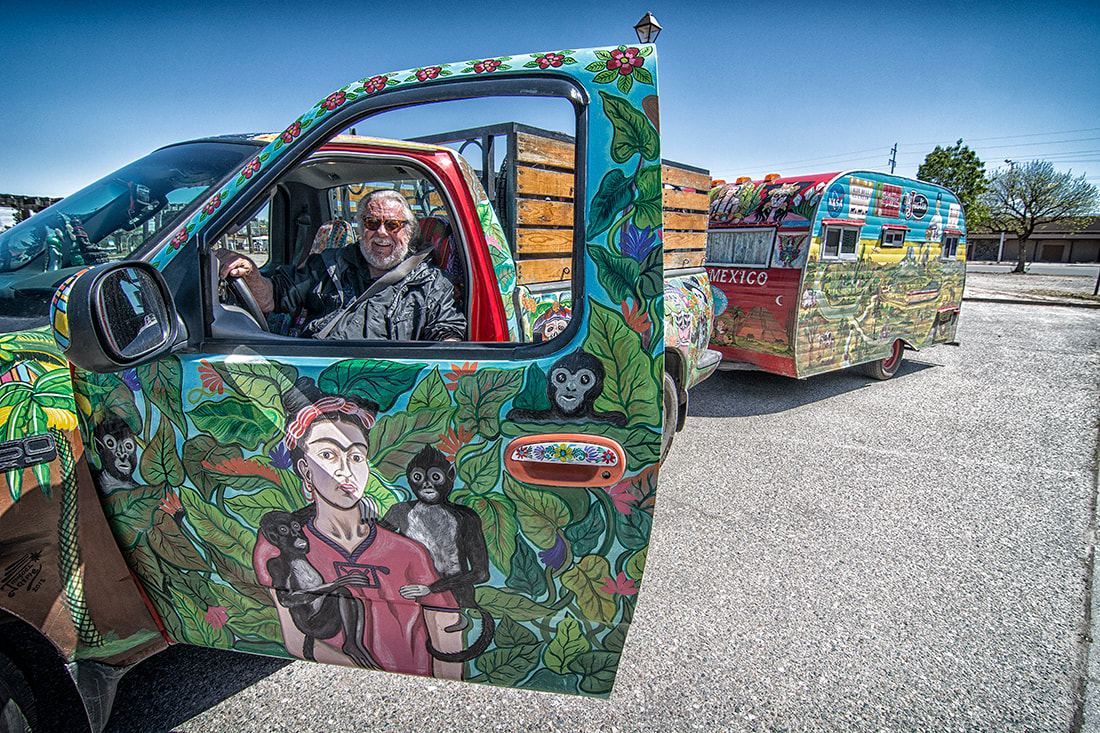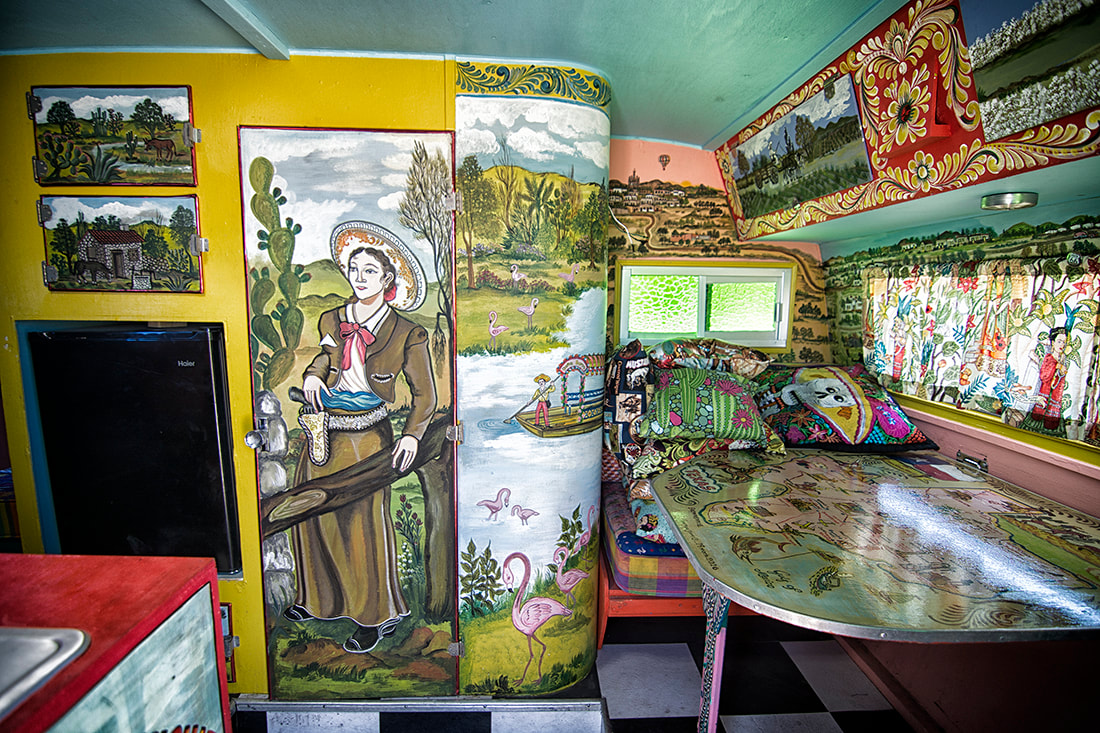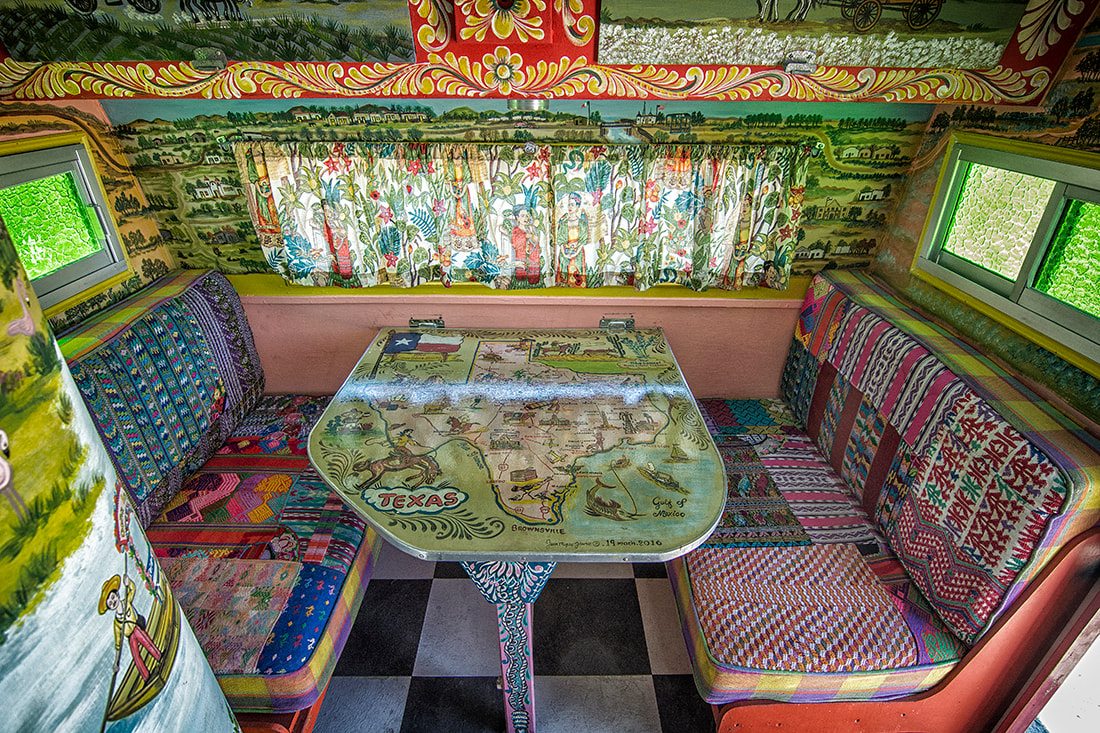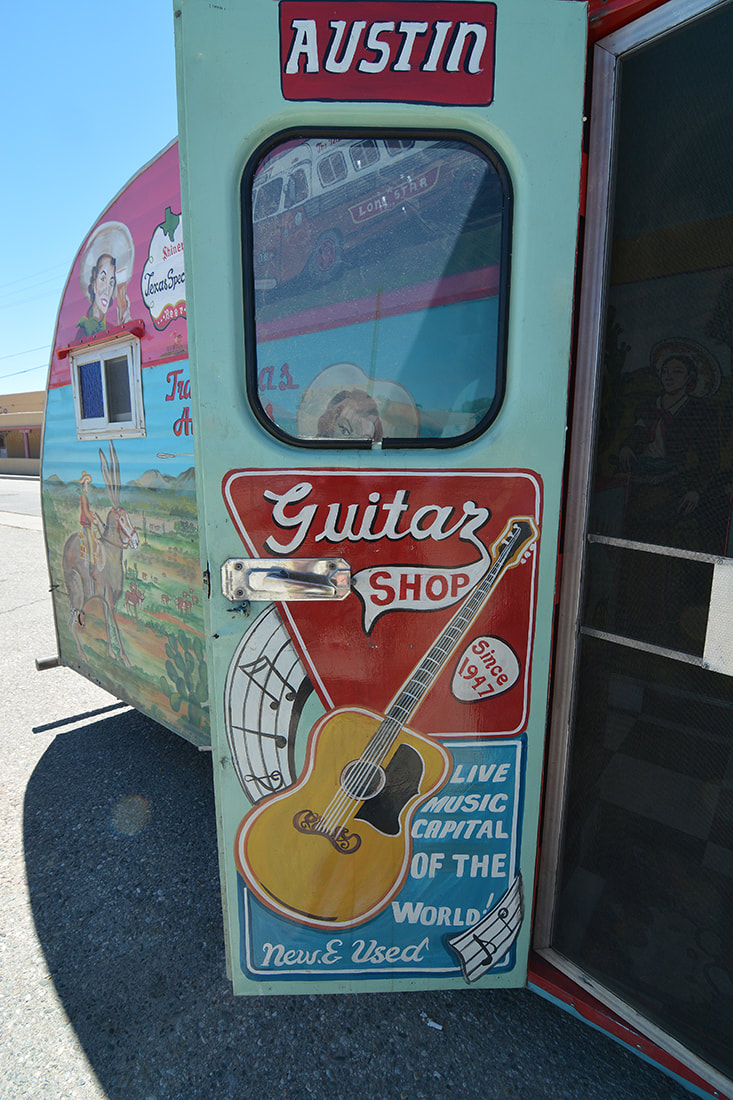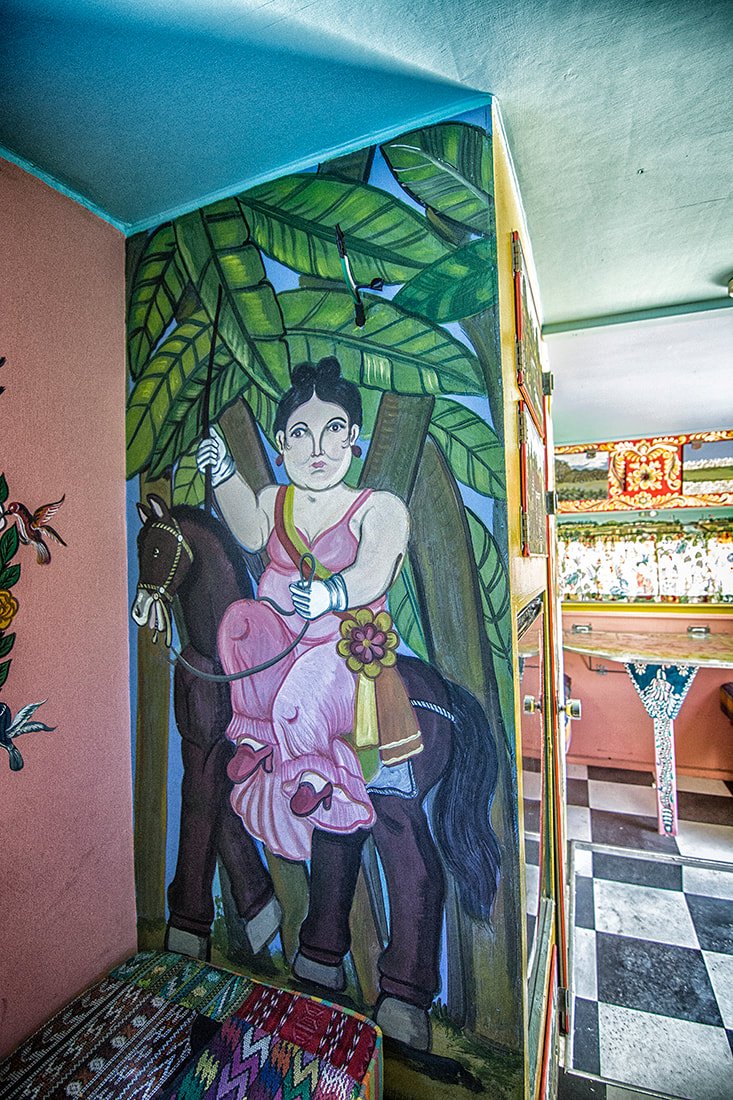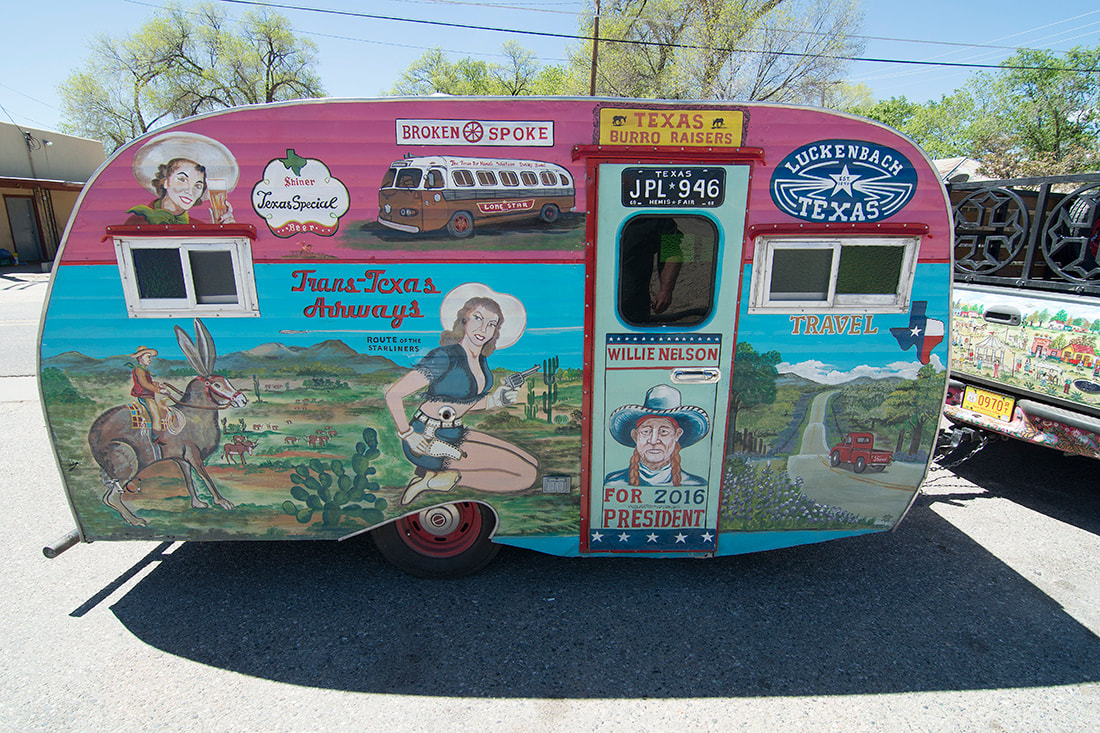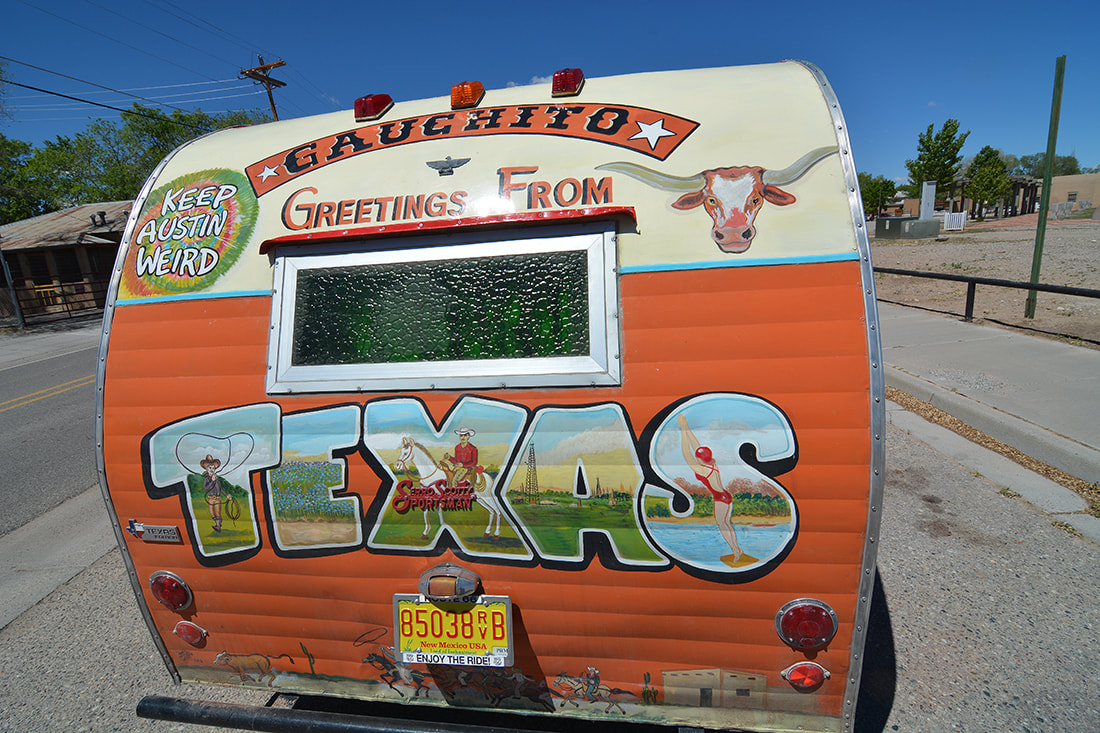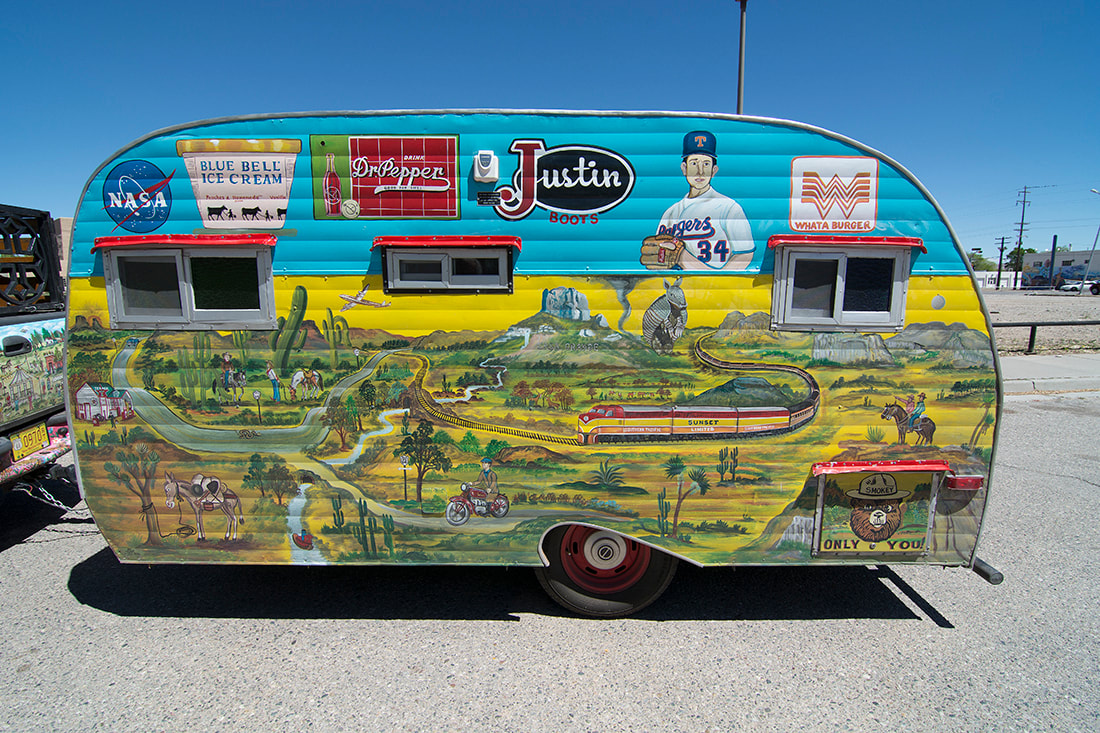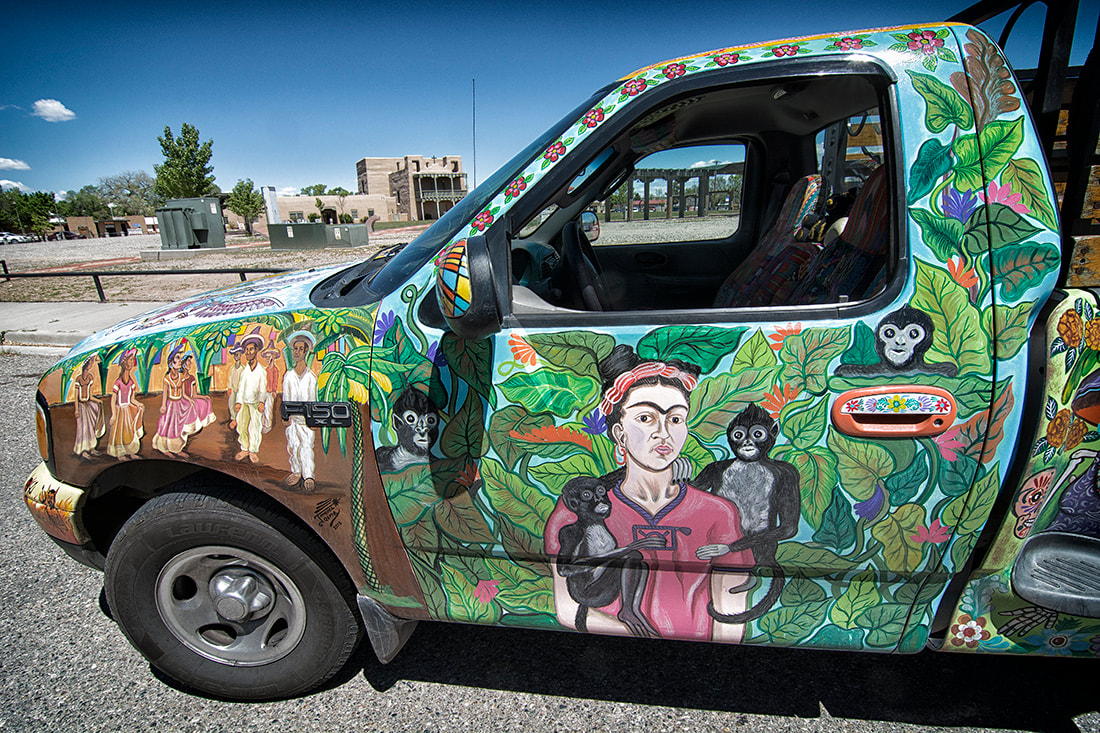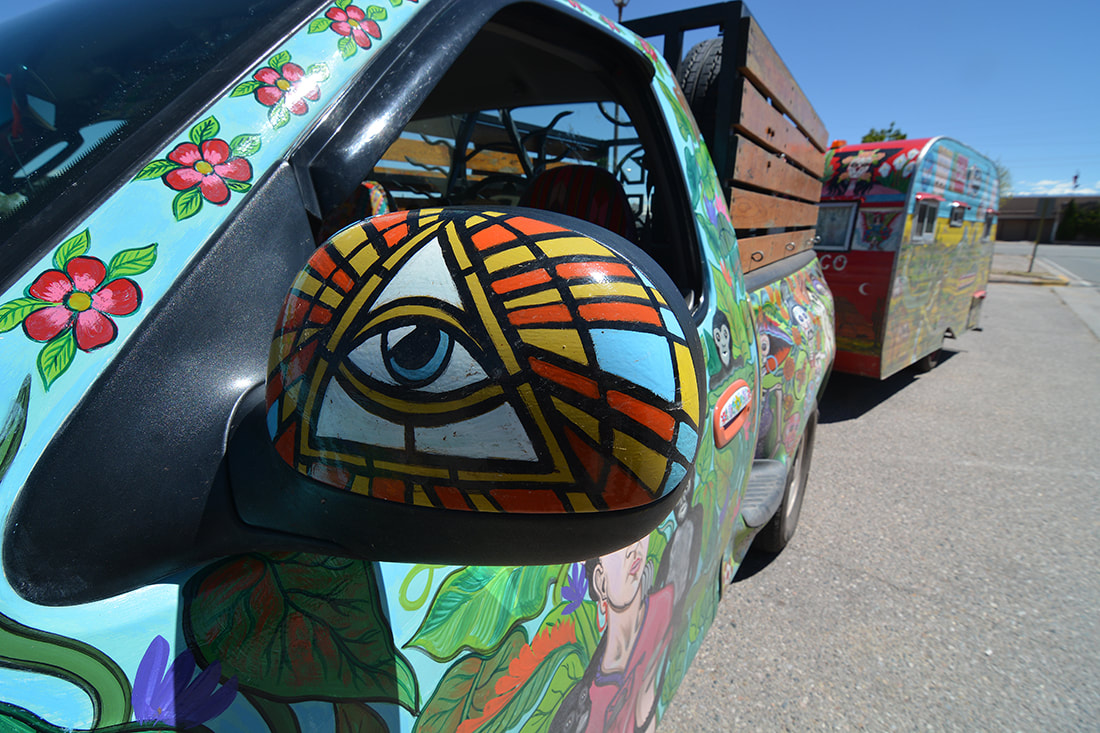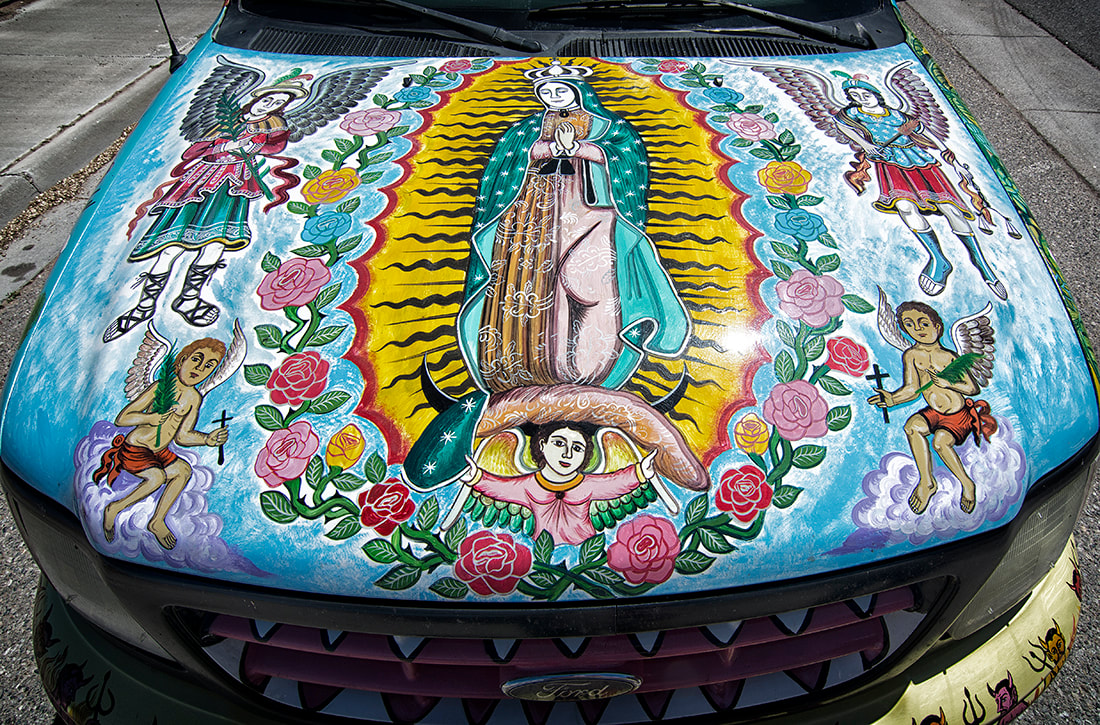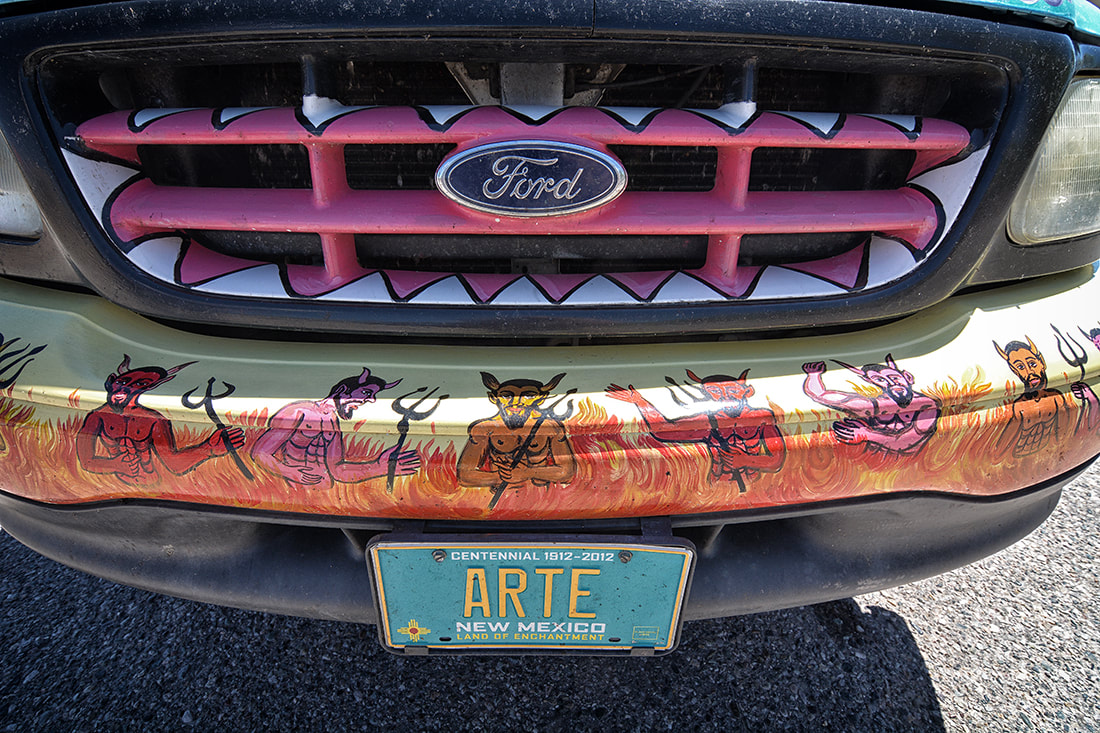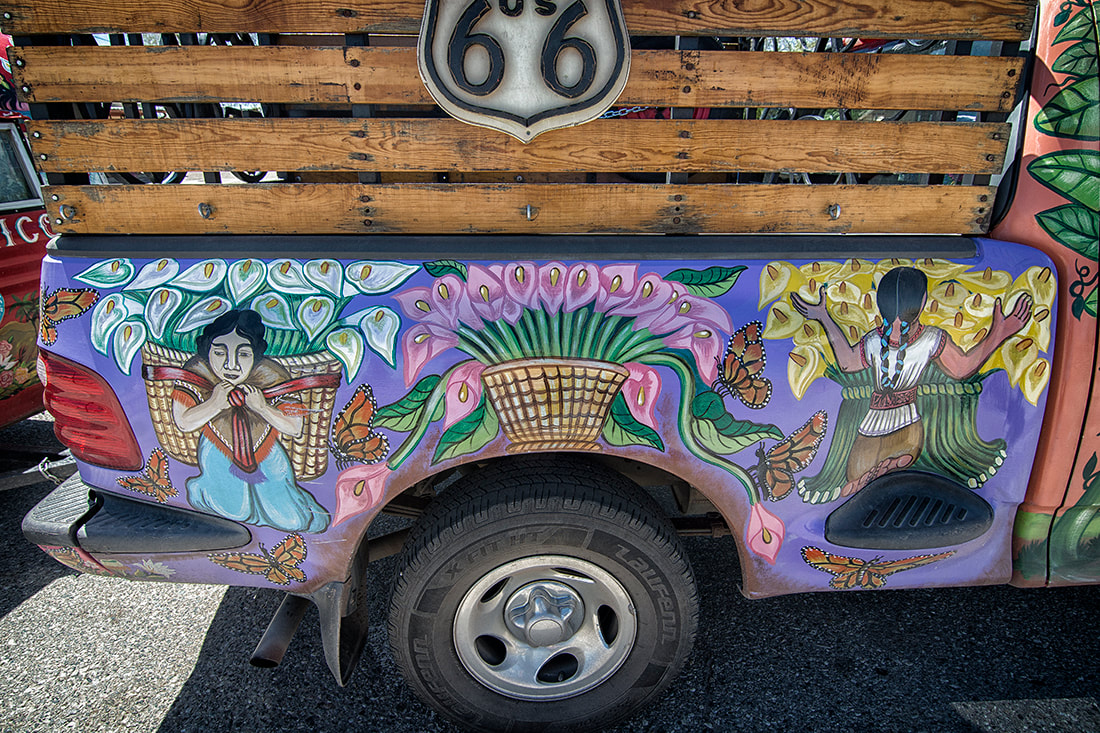John Lea's Amazing Painted Truck and Travel Trailer
John Lea sits in his amazing muralized pickup in Espanola, New Mexico. More photos after story.
Story and photos by Bob Eckert
There are many times when I’ve turned around on the road to take a photograph of something I notice, but John Lea’s painted truck and trailer was the first time I had to turn around and follow my potential story subject for a number of miles before I could get Lea to pull over and stop.
Passing Lea’s truck and trailer in Hernandez, on my way home, was like passing a very involved and intricate mobile mural, and seeing it was like having gravitational pull turn my car around and head back to Española.
I had hoped Lea would stop for gas but he seemed to be driving right through town, so I pulled next to him and signaled that I wanted him to pull over.
I assumed he thought I was crazy and he kept going. He was actually looking for a safe place to pull over but it crossed my mind that he might be looking for a police officer to report me to.
He eventually pulled off near the Plaza, and we talked a while. When talking to Lea, you get the impression that he’s a born storyteller.
“I live in San Miguel de Allende in Mexico and Northern New Mexico,” Lea explained. “My sometimes business partner down there is a man named Miguel Orduño, and he’s probably the most prolific painter in all of Mexico. He can be as detailed as Diego Rivera but he’s a rushy, rushy guy and he just turns it out. We’re not always in business, he’s an artist so he comes and goes. He’s a good guy but he doesn’t understand business — he understands art. Anyway, I painted the truck in 2013 because I didn’t want to repair a dent in the front fender that I got from bumping into a stump 10 years ago. It was painted white then.”
Lea says they painted the truck and it was kind of an instant success, which he didn’t expect it to be.
“That’s not why I painted it. People don’t talk to people in a white truck. Everybody talks to people in a truck painted like this. And I’m the ultimate extrovert, so it works out well.”
About 18 months or so ago, Lea was sitting in the McDonad’s in Taos and at that time was looking for a trailer, but he didn’t have a lot of money.
“So, I see this trailer on Craigslist and I don’t know where it is, it only shows the area code. So I called and I got an answering machine — I don’t talk to answering machines,” Lea says. “A day went by and I was in McDonald’s again drinking coffee and thought I’d call again and see what happens. A man answered the phone and I asked him if he still had the trailer for sale. He said, ‘I still do and I’ve lowered the price from $800 to $400.’ Before I even said anything. I told him I’d like to look at it and asked him where he was located, which happened to be Los Luceros.”
The trailer was sitting out there next to some storage buildings.
“I went in there and said to him, ‘Before we negotiate let just tell you I don’t have any money.’ I had $42 at the time,” Lea explains. “But I had my World Series ring. I was a professional baseball scout for the Arizona Diamondbacks. We won the World Series in 2001. I used to own Baseball USA. I told him that I had $42, but that I had a World Series ring and that I would be happy to give that to him as collateral for 10 or 15 days until I received my Social Security check and I would then come back and pay him. He said that was fine.”
Which prompted the questions, how did he become a baseball scout.
“I asked about 20 people if they needed a scout, (he says this matter of factly, like just asking around and getting a job as a professional baseball scout was the most natural thing in the world) and the 20th one said, ‘Yes.’ I played high school ball and a little college. I also coached. I know the game.”
It was then time to talk selling price of the trailer.
“I said $300. He said, ‘No way.’ He said, ‘$375,’ and I said ‘$350.’ We ended at $365. He told me it had good tires on it and we made the deal with a handshake — he even gave me the title. The title was 1984 in Arizona. It had apparently been sitting in Dixon for quite a while,” Lea says. “I got about half a mile on the highway pulling this rattily ass old trailer and a tire popped. Somebody passed by who knew him and went back and got him for me. He went and got a tire somewhere in Española and brought it back to me for $35, so I was back up to $400.”
Lea returned to give him the money and the seller said, “I was really hoping you wouldn’t come back. I wanted to keep your ring.”
The deal was made.
“It was a piece of junk,” Admits Lea. “I towed it to Mexico where it sat for about four months. Another man, Jesus, and I — I also do tile mosaic work — he’s my handyman, we tore this (the trailer) down to the frame in about a day. The plywood was all rotten so we replaced all the plywood. Then I called Miguel, my painter/business partner, after Jesus and I did the inside.”
As you gaze at the truck and trailer, Lea talks about Art Car Parades, which you may or may not be familiar with.
“I won the Houston Art Car Parade last year. I did art car parades all over the country last spring. I just did Houston. I do five or six a year. I’ve done them in Houston, Victoria, Texas; Tulsa, Okla.; Chattanooga, Tenn.; Seattle, Wash.; Trinidad, Colo.; San Francisco… they’re all over.”
At this point, Lea asks if I want to see the interior of the trailer, prior to getting a “tour” of the outside. I replied yes enthusiastically, and, if you care to, you can come along on the “tour.”
As you look through the trailer’s door, you see a woman painted on the bathroom door.
“That’s Poncho Villa’s girlfriend,” Lea explains, as he puts some pillows on his sofa/bed. “There is a Fernando Botero right here (next to the bed). He’s a Columbian artist who is still alive. He’s very old. He paints ‘gordo’ people. He makes the horse look big, but the person is even bigger. I’ve got one on the passenger truck door of ‘El Presidente.’”
There is a story on the front (interior) wall starting on the left is San Miguel de Allende.
“If you follow the path above the window, below the shelves, you’ll see a road that leads up to the Rio Grande,” Lea says. “That’s me, right in the middle of the Rio Grande, coming back from Mexico to Texas. That’s Laredo, the old crossing. You can see a small shack on the Mexican side and a big building on the American side. It keeps on going and ends up in Austin. You can see the larger buildings and airport in Austin. That was my typical route (not, you assume, swimming the Rio Grande).
Lea points to a painting on a man on the side of the “kitchen” cabinet right inside to trailer’s entrance.
“The trailer itself, on the title. Is called a Cerro Scotty Gaucho,” explains Lea. “So my truck has always been Don Burro — I name things — and I had to think of a name for the trailer. So Gauchito became the name of the trailer — not knowing what Gauchito was at the time. I found out that Gauchito (cover image) is a guy named Antonio Gil, in Argentina — you’re facing him right there (on the side of the cabinet right inside the trailer entrance door). He is revered as Guadalupe. He’s the Guadalupe of Argentina. So it became even more significant — the name of the trailer — even though that wasn’t my initial intent.”
The ‘Tour” then continues outside. Lea points to various areas within the “mobile mural” and names them.
“The truck is Mexico. There is only one painting on it that’s not Mexico and that’s another Botero — ‘El Presidente.’ The trailer — the front is Mexico. The rest of the trailer is Texas. It’s my past. I’m 71. This is around Llano, Texas, just west of Austin. (the red truck and blue bonnets). This is Lukenbock. This is me, just my name, John Patrick Lea. I left the one off 1946, the 68 is the date of the trailer. Made in Bristol, Okalahoma. This is a bus that sits in front of the Broken Spoke in Austin — it’s now surrounded by condominiums. It’s a nightclub. I once met Bill Clinton there. This is a Jackalope. That’s an old Trans-Texas Airways ad. The back is an old post card. (Wish you were here style) With the name, Gauchito, on top.”
Out of curiosity, I ask Lea how many times he’s been pulled over, like I did today. He replies, “First time. A lot of people talk to me but nobody’s ever pulled me over.”
Lea walks around to the left side of the trailer and continues the “Tour.”
Lea points to two men on horseback and says, “This is my friend Bob Peterson and I. I grew up with him. That’s me in the pink shirt and I’m pointing out the armadillo that is coming down from the ‘tornada.’ We’ve known each other since the crib.”
And then, reminiscing, he points to the train winding its way through the landscape.
“This is the Sunset Limited. It’s gong through Big Bend and we used to ride this train from Orange, Texas, to Houston to go to an ice rink when we were kids. My mother used to take us to the train station at four o’clock in the morning. They don’t do that anymore. That train comes through New Mexico, as well, and goes to Los Angeles.”
Lea points out Route 66, although not really where it is in Texas.
“And this is Scuffy the Tugboat, a children’s book,” Lea says. “That’s my life. I’ve traveled all over the world. Europe 300 times. Asia. All over the world.”
Why did he travel so much?
“Uh, I don’t know,” Lea says, as he seems to ponder the question. “It started with genealogy and I couldn’t afford it so I invented companies (that enabled him to travel)… I sold used Levi 501s in London and made a ton of money off that. And then that died and I became a professional baseball scout for 10 years.”
Lea then turns back to the trailer and continues the “Tour,” which seems to have taken a turn into being an autobiography of John Lea. He points to a number of images on the top of the trailer and comments on them.
“These are all Texas icons,” Lea says. “My uncle worked for NASA, my family started Blue Bell Ice Cream — my great-grandmother’s brother was the original incorporator of the Brenham Creamery in 1883, I think it was. Dr. Pepper is just something I like. Justin boots is after my son. This is Nolan Ryan’s Hall of Fame picture. He’s a friend of mine. I played against him in high school. Whataburger, I have dreams of Whataburger when I’m away.”
Lea points to a spaceship and says, “This is my family landing. (The alien spaceship, instead of the Mayflower). We came in with the cattle mutilations.”
Which brought us to the pickup truck.
Lea points proudly to a new license.
“I got this neat license plate last week in Santa Fe, Route 66. This is Day of the Dead, obviously. Frida Khalo with my family (on the driver’s side door). These dancers are from Michoacán. This is the third eye (on the rear view mirror). The third eye for your enlightenment.”
Lea then invites me to pull myself up onto the truck so I can see the solar system painted on its roof.
“We’ve got Guadalupe with San Rafael on the hood,” Lea continues. “And we’ve got the guardians of the road here… (on the dashboard) I don’t discriminate. I’ve got Buddha, Ganesh, Roswell (alien) and Guadalupe. Someone asked me why I didn’t have a Jesus and I said, ‘Not sure about him yet.’”
On the right hand rear view mirror is a symbol.
“This is symbolic of the pilgrimage to Campesello in Spain, which I have done 12 times,” Lea explains. “It’s an ancient pilgrimage route across Europe. People walk. It’s Santiago de Campestello. That’s the symbol that they put up along the route.”
And after pointing out “El Presidente,” Lea says, “And these are Diego Rivera. The monarchs winter in Michoacán, which is about 200 miles from where I live when I’m in Mexico.”
And with that, the “Tour” ends, since Lea has an appointment he needs to get to in Santa Fe.
There are many times when I’ve turned around on the road to take a photograph of something I notice, but John Lea’s painted truck and trailer was the first time I had to turn around and follow my potential story subject for a number of miles before I could get Lea to pull over and stop.
Passing Lea’s truck and trailer in Hernandez, on my way home, was like passing a very involved and intricate mobile mural, and seeing it was like having gravitational pull turn my car around and head back to Española.
I had hoped Lea would stop for gas but he seemed to be driving right through town, so I pulled next to him and signaled that I wanted him to pull over.
I assumed he thought I was crazy and he kept going. He was actually looking for a safe place to pull over but it crossed my mind that he might be looking for a police officer to report me to.
He eventually pulled off near the Plaza, and we talked a while. When talking to Lea, you get the impression that he’s a born storyteller.
“I live in San Miguel de Allende in Mexico and Northern New Mexico,” Lea explained. “My sometimes business partner down there is a man named Miguel Orduño, and he’s probably the most prolific painter in all of Mexico. He can be as detailed as Diego Rivera but he’s a rushy, rushy guy and he just turns it out. We’re not always in business, he’s an artist so he comes and goes. He’s a good guy but he doesn’t understand business — he understands art. Anyway, I painted the truck in 2013 because I didn’t want to repair a dent in the front fender that I got from bumping into a stump 10 years ago. It was painted white then.”
Lea says they painted the truck and it was kind of an instant success, which he didn’t expect it to be.
“That’s not why I painted it. People don’t talk to people in a white truck. Everybody talks to people in a truck painted like this. And I’m the ultimate extrovert, so it works out well.”
About 18 months or so ago, Lea was sitting in the McDonad’s in Taos and at that time was looking for a trailer, but he didn’t have a lot of money.
“So, I see this trailer on Craigslist and I don’t know where it is, it only shows the area code. So I called and I got an answering machine — I don’t talk to answering machines,” Lea says. “A day went by and I was in McDonald’s again drinking coffee and thought I’d call again and see what happens. A man answered the phone and I asked him if he still had the trailer for sale. He said, ‘I still do and I’ve lowered the price from $800 to $400.’ Before I even said anything. I told him I’d like to look at it and asked him where he was located, which happened to be Los Luceros.”
The trailer was sitting out there next to some storage buildings.
“I went in there and said to him, ‘Before we negotiate let just tell you I don’t have any money.’ I had $42 at the time,” Lea explains. “But I had my World Series ring. I was a professional baseball scout for the Arizona Diamondbacks. We won the World Series in 2001. I used to own Baseball USA. I told him that I had $42, but that I had a World Series ring and that I would be happy to give that to him as collateral for 10 or 15 days until I received my Social Security check and I would then come back and pay him. He said that was fine.”
Which prompted the questions, how did he become a baseball scout.
“I asked about 20 people if they needed a scout, (he says this matter of factly, like just asking around and getting a job as a professional baseball scout was the most natural thing in the world) and the 20th one said, ‘Yes.’ I played high school ball and a little college. I also coached. I know the game.”
It was then time to talk selling price of the trailer.
“I said $300. He said, ‘No way.’ He said, ‘$375,’ and I said ‘$350.’ We ended at $365. He told me it had good tires on it and we made the deal with a handshake — he even gave me the title. The title was 1984 in Arizona. It had apparently been sitting in Dixon for quite a while,” Lea says. “I got about half a mile on the highway pulling this rattily ass old trailer and a tire popped. Somebody passed by who knew him and went back and got him for me. He went and got a tire somewhere in Española and brought it back to me for $35, so I was back up to $400.”
Lea returned to give him the money and the seller said, “I was really hoping you wouldn’t come back. I wanted to keep your ring.”
The deal was made.
“It was a piece of junk,” Admits Lea. “I towed it to Mexico where it sat for about four months. Another man, Jesus, and I — I also do tile mosaic work — he’s my handyman, we tore this (the trailer) down to the frame in about a day. The plywood was all rotten so we replaced all the plywood. Then I called Miguel, my painter/business partner, after Jesus and I did the inside.”
As you gaze at the truck and trailer, Lea talks about Art Car Parades, which you may or may not be familiar with.
“I won the Houston Art Car Parade last year. I did art car parades all over the country last spring. I just did Houston. I do five or six a year. I’ve done them in Houston, Victoria, Texas; Tulsa, Okla.; Chattanooga, Tenn.; Seattle, Wash.; Trinidad, Colo.; San Francisco… they’re all over.”
At this point, Lea asks if I want to see the interior of the trailer, prior to getting a “tour” of the outside. I replied yes enthusiastically, and, if you care to, you can come along on the “tour.”
As you look through the trailer’s door, you see a woman painted on the bathroom door.
“That’s Poncho Villa’s girlfriend,” Lea explains, as he puts some pillows on his sofa/bed. “There is a Fernando Botero right here (next to the bed). He’s a Columbian artist who is still alive. He’s very old. He paints ‘gordo’ people. He makes the horse look big, but the person is even bigger. I’ve got one on the passenger truck door of ‘El Presidente.’”
There is a story on the front (interior) wall starting on the left is San Miguel de Allende.
“If you follow the path above the window, below the shelves, you’ll see a road that leads up to the Rio Grande,” Lea says. “That’s me, right in the middle of the Rio Grande, coming back from Mexico to Texas. That’s Laredo, the old crossing. You can see a small shack on the Mexican side and a big building on the American side. It keeps on going and ends up in Austin. You can see the larger buildings and airport in Austin. That was my typical route (not, you assume, swimming the Rio Grande).
Lea points to a painting on a man on the side of the “kitchen” cabinet right inside to trailer’s entrance.
“The trailer itself, on the title. Is called a Cerro Scotty Gaucho,” explains Lea. “So my truck has always been Don Burro — I name things — and I had to think of a name for the trailer. So Gauchito became the name of the trailer — not knowing what Gauchito was at the time. I found out that Gauchito (cover image) is a guy named Antonio Gil, in Argentina — you’re facing him right there (on the side of the cabinet right inside the trailer entrance door). He is revered as Guadalupe. He’s the Guadalupe of Argentina. So it became even more significant — the name of the trailer — even though that wasn’t my initial intent.”
The ‘Tour” then continues outside. Lea points to various areas within the “mobile mural” and names them.
“The truck is Mexico. There is only one painting on it that’s not Mexico and that’s another Botero — ‘El Presidente.’ The trailer — the front is Mexico. The rest of the trailer is Texas. It’s my past. I’m 71. This is around Llano, Texas, just west of Austin. (the red truck and blue bonnets). This is Lukenbock. This is me, just my name, John Patrick Lea. I left the one off 1946, the 68 is the date of the trailer. Made in Bristol, Okalahoma. This is a bus that sits in front of the Broken Spoke in Austin — it’s now surrounded by condominiums. It’s a nightclub. I once met Bill Clinton there. This is a Jackalope. That’s an old Trans-Texas Airways ad. The back is an old post card. (Wish you were here style) With the name, Gauchito, on top.”
Out of curiosity, I ask Lea how many times he’s been pulled over, like I did today. He replies, “First time. A lot of people talk to me but nobody’s ever pulled me over.”
Lea walks around to the left side of the trailer and continues the “Tour.”
Lea points to two men on horseback and says, “This is my friend Bob Peterson and I. I grew up with him. That’s me in the pink shirt and I’m pointing out the armadillo that is coming down from the ‘tornada.’ We’ve known each other since the crib.”
And then, reminiscing, he points to the train winding its way through the landscape.
“This is the Sunset Limited. It’s gong through Big Bend and we used to ride this train from Orange, Texas, to Houston to go to an ice rink when we were kids. My mother used to take us to the train station at four o’clock in the morning. They don’t do that anymore. That train comes through New Mexico, as well, and goes to Los Angeles.”
Lea points out Route 66, although not really where it is in Texas.
“And this is Scuffy the Tugboat, a children’s book,” Lea says. “That’s my life. I’ve traveled all over the world. Europe 300 times. Asia. All over the world.”
Why did he travel so much?
“Uh, I don’t know,” Lea says, as he seems to ponder the question. “It started with genealogy and I couldn’t afford it so I invented companies (that enabled him to travel)… I sold used Levi 501s in London and made a ton of money off that. And then that died and I became a professional baseball scout for 10 years.”
Lea then turns back to the trailer and continues the “Tour,” which seems to have taken a turn into being an autobiography of John Lea. He points to a number of images on the top of the trailer and comments on them.
“These are all Texas icons,” Lea says. “My uncle worked for NASA, my family started Blue Bell Ice Cream — my great-grandmother’s brother was the original incorporator of the Brenham Creamery in 1883, I think it was. Dr. Pepper is just something I like. Justin boots is after my son. This is Nolan Ryan’s Hall of Fame picture. He’s a friend of mine. I played against him in high school. Whataburger, I have dreams of Whataburger when I’m away.”
Lea points to a spaceship and says, “This is my family landing. (The alien spaceship, instead of the Mayflower). We came in with the cattle mutilations.”
Which brought us to the pickup truck.
Lea points proudly to a new license.
“I got this neat license plate last week in Santa Fe, Route 66. This is Day of the Dead, obviously. Frida Khalo with my family (on the driver’s side door). These dancers are from Michoacán. This is the third eye (on the rear view mirror). The third eye for your enlightenment.”
Lea then invites me to pull myself up onto the truck so I can see the solar system painted on its roof.
“We’ve got Guadalupe with San Rafael on the hood,” Lea continues. “And we’ve got the guardians of the road here… (on the dashboard) I don’t discriminate. I’ve got Buddha, Ganesh, Roswell (alien) and Guadalupe. Someone asked me why I didn’t have a Jesus and I said, ‘Not sure about him yet.’”
On the right hand rear view mirror is a symbol.
“This is symbolic of the pilgrimage to Campesello in Spain, which I have done 12 times,” Lea explains. “It’s an ancient pilgrimage route across Europe. People walk. It’s Santiago de Campestello. That’s the symbol that they put up along the route.”
And after pointing out “El Presidente,” Lea says, “And these are Diego Rivera. The monarchs winter in Michoacán, which is about 200 miles from where I live when I’m in Mexico.”
And with that, the “Tour” ends, since Lea has an appointment he needs to get to in Santa Fe.
To contact Bob Eckert for assignments, consultations or workshops, please email [email protected]
or use the contact form on the About page
or use the contact form on the About page
